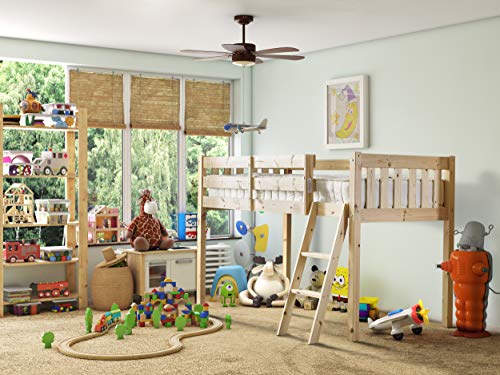An Bunk Bed Online Success Story You'll Never Be Able To

How to Shop Bunk Bed Furniture
Bunk beds are fantastic furniture choices for children's' rooms. There are many different designs available, from attached desks to staircase bunks.

Finding the perfect bunk bed can be a tough task. It's important to choose a bed that both of you enjoy. It's also important to pick the correct style, design and size.
How to Choose the Perfect Bunk Bed
There are a lot of different bunk beds you can pick from, but it is important be sure to select the right one for your child. When choosing the ideal bunk beds for your child, it's important to take into account the height of the bed and the size of the room.
The bunk bed you choose should be comfortable for your child. It should be safe and have plenty of storage space. It should have a mattress that is suitable to the age and needs of your child.
It can be a challenge to choose the right bunk beds, however, you must think about how your child will use them and what features they would like. You may want to consider adding a trundle to give your child more storage space or drawers for storage.
Consider the material the bunk bed frame is constructed of. Some bunk beds are constructed of metal and some are made of wood. This is a fantastic option for the bedroom of your child, but it may not be as sturdy.
Bunk beds are an excellent way to give your child their own space in their bedroom, and can be decorated to match their personality. Your child will feel more secure and have the chance to be themselves in their own space.
A bunk bed is an affordable and practical option for your family, regardless of whether you're building a new house or renovating one that already exists. It can be utilized in guest rooms in a kid's space, a cabin for vacation or.
Stairs or Ladders
Bunk beds come in many different types, shapes and sizes. Pick a bunk bed that will complement your style and décor and the needs of your child.
For instance, you might think about a full over twin bed or a full over full bunk bed with stairs that double as storage space. These types of beds are more fashionable and can free up a lot of room.
Stairs are likely to be safer than ladders, especially for younger children. They have wider steps and a sturdy rail that is surrounded by your child while they climb. Some have grooves to prevent slipping.
A bunk bed with stairs is a secure comfortable and practical option for your kids. It also allows for the saving of space in the room and can be combined with a variety of decorative styles.
If you choose a bunk bed that has an incline, ensure that the ladder's rungs are not too narrow. You can also place a cushion over the ladder to make it more comfortable.
Ladders can be easier to climb for kids younger than however, they can be more difficult to climb for older ones. They are also more expensive than stairways, and you need to consider if you're willing and able to pay the extra cost.
After the bunk bed is constructed and put in place, you can instruct your child on how to use it in a safe manner. When climbing, it's important to use both hands and face the stairs or ladder. It is also essential to supervise your child when they use the bunk bed.
Age of the Child
When choosing a bunkbed the age of your child must be considered. When choosing whether or not you should purchase a bunk bed, you must consider your child's safety, happiness, and sleeping habits.
In general it is recommended that children are at least six years of age to be able to sleep on the top bunk. This is because they are more likely to be able to climb up and down the ladder, or be able to sleep on the mattress in the evening.
If you have a younger child, it's important to take into consideration the level of their maturity and how comfortable they are with heights. If your child is frightened to be on a higher bunk, you may think about a bed with a lower level.
Also, you must think about the space you have in your bedroom. Find the ceiling measurements and make sure that the bottom and top bunks will be able to fit comfortably. You must leave at least 30 inches (2.5 feet) of space between the beds and the ceiling to stop your child from hitting their head against the roof or the top bunk while they sit up.
In addition, consider bunk beds that come with additional safety features. For example, many bunk beds have guard rails that run along the sides to prevent children from falling off the top bunk or getting trapped in the bottom one.
Floor Space
Bunk beds are an excellent way to save room, whether you have one child or two. They provide kids with more space to move around their room and also allow them to have a desk, play space or other furniture.
beds bunk can be placed up to three feet high, and typically come in different configurations to meet your needs. Some models are designed for guests, while others include a desk as well as storage beneath.
If you want to save space on your floor, select bunk beds that can be placed horizontally instead of vertically. This may not be possible in all circumstances, but it could be a great start.
When deciding on the right bunk beds, it is important to consider your ceiling heights. The standard ceiling height is between 8' and 9.' You can find loft beds as well as bunk beds with lower heights that will be able to fit into smaller spaces.
You must consider the characteristics of the bunk bed and how they work in your bedroom. For instance, you will be sure that the top bunk is equipped with a ladder or guard rails as well as the bottom bed is equipped with drawers underneath. You should consider how your child will use the beds - do they sleep in the top bunk for the majority of the time or do they require a desk that has storage underneath the bottom bed?
Style
Bunk beds come in many different designs and are able to be customized to suit the bedroom of your child. They are also a great way to save space in your child's room, especially if you're short on floor space and want to preserve it.
There are a variety of bunk beds, from basic models or the standard model to lofts that have desks. There are bunks with built-in bookcases or drawers if you're looking for more storage.
The best bunk beds are made with quality wood along with a sturdy frame and comfortable mattresses. The most suitable mattresses for bunk beds are those that are between 5 and 6 inches thick. This will allow the rails for guarding to be visible above the mattress's top and increase the security.
If you are purchasing a bunk bed and you are looking for safety features, such as frames for guardrails that are connected to the bed. This will stop your child from slipping out of bed when they sleep.
Some bunk beds have a short ladder attached to the upper and lower rails. This type of ladder lets your child access to drawers under the bed and climbs up and down without getting blocking their path.
You can also select from a wide variety of mattresses so that your child is comfortable and has the support they require. There are a variety of options available, from latex to hybrid foam. You can also look for a bunk bed that comes with a slide so that your child will be able to have fun when they wake up in the morning.
Safety
When purchasing a bunk bed, it is important to take into consideration the safety aspect. The safety features in a bunk bed like ladders and guard rails are designed to prevent injuries or accidents that result from falling or entrapment or structural failure.
The most essential of these features is a safety railing, that should be attached to all four sides of the upper bunk. This will prevent children from falling down and getting injured on the top bunk.
The space between the guardrails and the sides of the bed should not be wider than 3 1/2 inchs. This will prevent your child from rolling under the bed when they are sleeping.
You should also make sure that the guardrails are 16cm taller than your mattress to keep your child from falling out of bed. In addition, the mattresses in the lower and upper bunk should be snugly positioned against all four sides of the bed. They should also be not more than 15cm in depth.
If you're in the market for bunk beds, make sure that they are built to meet the strict standards of your country's safety agency. These regulations apply to every aspect of bunk bed construction and design with a particular emphasis on gaps and space that are likely for small legs, arms and heads to be trapped in.
